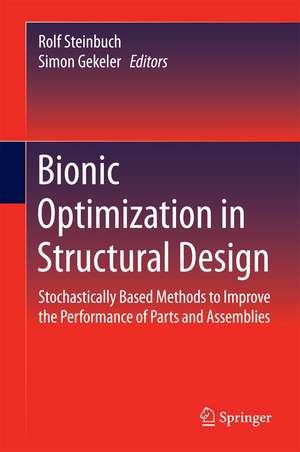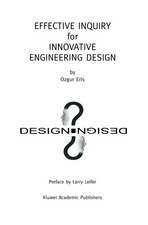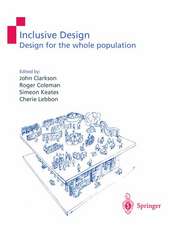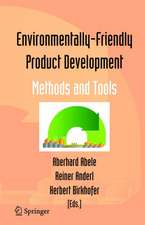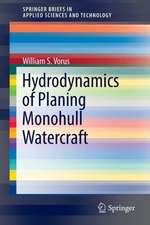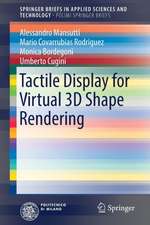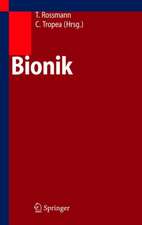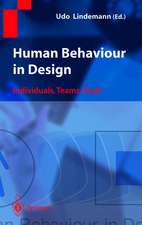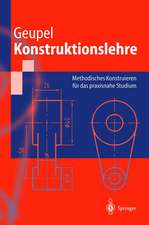Bionic Optimization in Structural Design: Stochastically Based Methods to Improve the Performance of Parts and Assemblies
Editat de Rolf Steinbuch, Simon Gekeleren Limba Engleză Hardback – 20 noi 2015
Bionic Optimization means finding the best solution to a problem using methods found in nature. As Evolutionary Strategies and Particle Swarm Optimization seem to be the most important methods for structural optimization, we primarily focus on them. Other methods such as neural nets or ant colonies are more suited to control or process studies, so their basic ideas are outlined in order to motivate readers to start using them.
A set of sample applications shows how Bionic Optimization works in practice. From academic studies on simple frames made of rods to earthquake-resistant buildings, readers follow the lessons learned, difficulties encountered and effective strategies for overcoming them. For the problem of tuned mass dampers, which play an important role in dynamic control, changing the goal and restrictions paves the way for Multi-Objective-Optimization. As most structural designers today use commercial software such as FE-Codes or CAE systems with integrated simulation modules, ways of integrating Bionic Optimization into these software packages are outlined and examples of typical systems and typical optimization approaches are presented.
The closing section focuses on an overview and outlook on reliable and robust as well as on Multi-Objective-Optimization, including
discussions of current and upcoming research topics in the field concerning a unified theory for handling stochastic design processes.
| Toate formatele și edițiile | Preț | Express |
|---|---|---|
| Paperback (1) | 549.81 lei 6-8 săpt. | |
| Springer Berlin, Heidelberg – 13 feb 2018 | 549.81 lei 6-8 săpt. | |
| Hardback (1) | 640.55 lei 6-8 săpt. | |
| Springer Berlin, Heidelberg – 20 noi 2015 | 640.55 lei 6-8 săpt. |
Preț: 640.55 lei
Preț vechi: 753.60 lei
-15% Nou
Puncte Express: 961
Preț estimativ în valută:
122.58€ • 133.11$ • 102.97£
122.58€ • 133.11$ • 102.97£
Carte tipărită la comandă
Livrare economică 22 aprilie-06 mai
Preluare comenzi: 021 569.72.76
Specificații
ISBN-13: 9783662465950
ISBN-10: 3662465957
Pagini: 200
Ilustrații: XII, 160 p. 103 illus., 6 illus. in color.
Dimensiuni: 155 x 235 x 17 mm
Greutate: 0.42 kg
Ediția:1st ed. 2016
Editura: Springer Berlin, Heidelberg
Colecția Springer
Locul publicării:Berlin, Heidelberg, Germany
ISBN-10: 3662465957
Pagini: 200
Ilustrații: XII, 160 p. 103 illus., 6 illus. in color.
Dimensiuni: 155 x 235 x 17 mm
Greutate: 0.42 kg
Ediția:1st ed. 2016
Editura: Springer Berlin, Heidelberg
Colecția Springer
Locul publicării:Berlin, Heidelberg, Germany
Public țintă
Professional/practitionerCuprins
Motivation.- Bionic Optimization Strategies.- Problems and Limitations of Bionic Optimization.- Application to CAE Problems.- Applications of Bionic Optimization.- Current Fields of Interest.- Future Tasks in Optimization.
Notă biografică
Professor Rolf Steinbuch, University of Reutlingen,
1977-1982 Fracture mechanics / safety analysis KWU/SIEMENS, Erlangen,
1982-1983 Design of Desalination plants BTB Leonberg
1984-1993 Simulation of car components at DaimlerChrysler Untertürkheim
since 1993 Professor (C3) Mathematics. Simulation and Mechanics at Reutlingen University, Dep. of Engineering
Simon Gekeler, University of Reutlingen
since 2011 Design optimization/sensitivity analysis, evaluation of design robustness and reliability, algorithm development Reutlingen Research Institute, Reutlingen University.
1977-1982 Fracture mechanics / safety analysis KWU/SIEMENS, Erlangen,
1982-1983 Design of Desalination plants BTB Leonberg
1984-1993 Simulation of car components at DaimlerChrysler Untertürkheim
since 1993 Professor (C3) Mathematics. Simulation and Mechanics at Reutlingen University, Dep. of Engineering
Simon Gekeler, University of Reutlingen
since 2011 Design optimization/sensitivity analysis, evaluation of design robustness and reliability, algorithm development Reutlingen Research Institute, Reutlingen University.
Textul de pe ultima copertă
The book provides suggestions on how to start using bionic optimization methods, including pseudo-code examples of each of the important approaches and outlines of how to improve them. The most efficient methods for accelerating the studies are discussed. These include the selection of size and generations of a study’s parameters, modification of these driving parameters, switching to gradient methods when approaching local maxima, and the use of parallel working hardware.
Bionic Optimization means finding the best solution to a problem using methods found in nature. As Evolutionary Strategies and Particle Swarm Optimization seem to be the most important methods for structural optimization, we primarily focus on them. Other methods such as neural nets or ant colonies are more suited to control or process studies, so their basic ideas are outlined in order to motivate readers to start using them.
A set of sample applications shows how Bionic Optimization works in practice. From academic studies on simple frames made of rods to earthquake-resistant buildings, readers follow the lessons learned, difficulties encountered and effective strategies for overcoming them. For the problem of tuned mass dampers, which play an important role in dynamic control, changing the goal and restrictions paves the way for Multi-Objective-Optimization. As most structural designers today use commercial software such as FE-Codes or CAE systems with integrated simulation modules, ways of integrating Bionic Optimization into these software packages are outlined and examples of typical systems and typical optimization approaches are presented.
The closing section focuses on an overview and outlook on reliable and robust as well as on Multi-Objective-Optimization, including
discussions of current and upcoming research topics in the field concerning a unified theory for handling stochastic design processes.
Bionic Optimization means finding the best solution to a problem using methods found in nature. As Evolutionary Strategies and Particle Swarm Optimization seem to be the most important methods for structural optimization, we primarily focus on them. Other methods such as neural nets or ant colonies are more suited to control or process studies, so their basic ideas are outlined in order to motivate readers to start using them.
A set of sample applications shows how Bionic Optimization works in practice. From academic studies on simple frames made of rods to earthquake-resistant buildings, readers follow the lessons learned, difficulties encountered and effective strategies for overcoming them. For the problem of tuned mass dampers, which play an important role in dynamic control, changing the goal and restrictions paves the way for Multi-Objective-Optimization. As most structural designers today use commercial software such as FE-Codes or CAE systems with integrated simulation modules, ways of integrating Bionic Optimization into these software packages are outlined and examples of typical systems and typical optimization approaches are presented.
The closing section focuses on an overview and outlook on reliable and robust as well as on Multi-Objective-Optimization, including
discussions of current and upcoming research topics in the field concerning a unified theory for handling stochastic design processes.
Caracteristici
Focus on the optimization of high-dimensional problems Easily applicable by pseudo-code examples Practical implementation and application Includes supplementary material: sn.pub/extras
